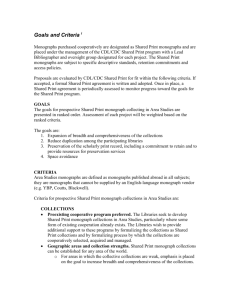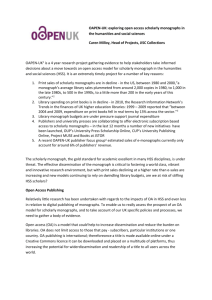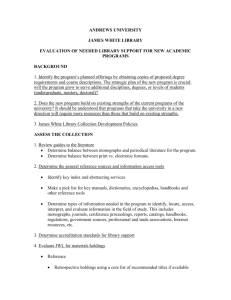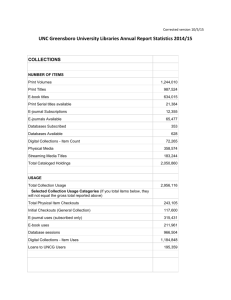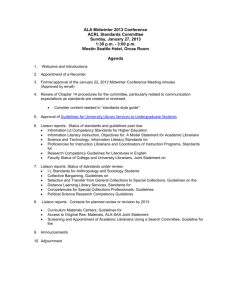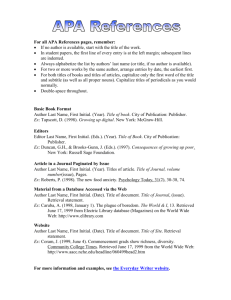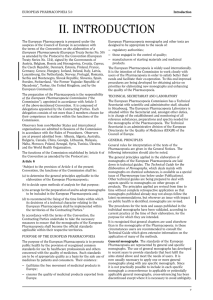word document
advertisement
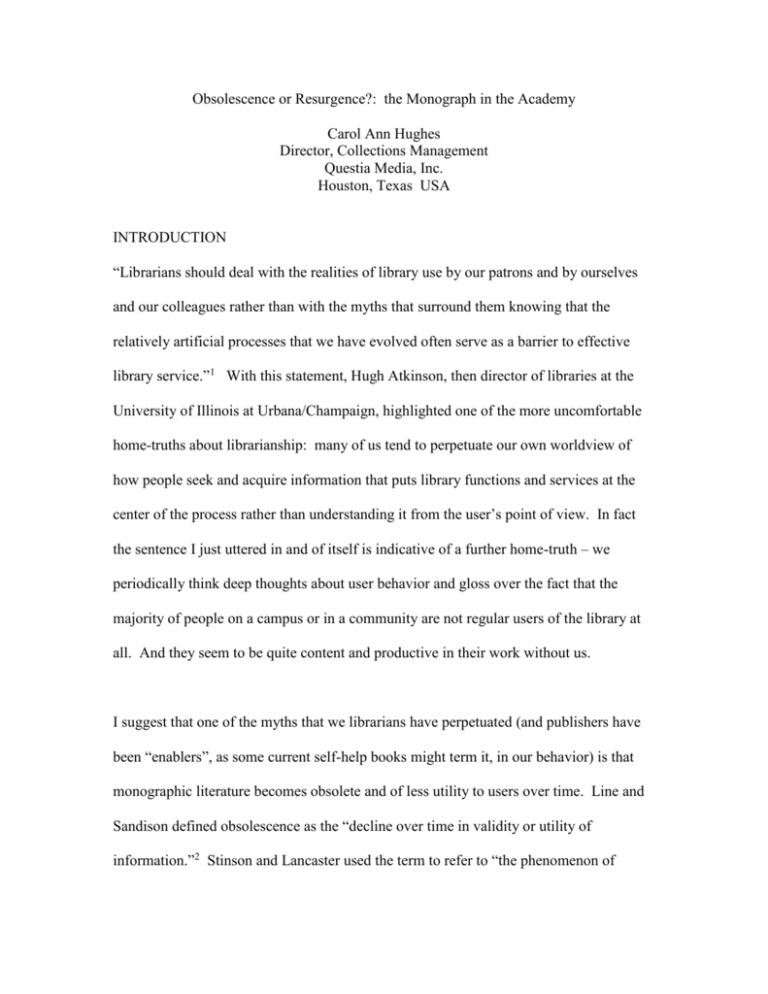
Obsolescence or Resurgence?: the Monograph in the Academy Carol Ann Hughes Director, Collections Management Questia Media, Inc. Houston, Texas USA INTRODUCTION “Librarians should deal with the realities of library use by our patrons and by ourselves and our colleagues rather than with the myths that surround them knowing that the relatively artificial processes that we have evolved often serve as a barrier to effective library service.”1 With this statement, Hugh Atkinson, then director of libraries at the University of Illinois at Urbana/Champaign, highlighted one of the more uncomfortable home-truths about librarianship: many of us tend to perpetuate our own worldview of how people seek and acquire information that puts library functions and services at the center of the process rather than understanding it from the user’s point of view. In fact the sentence I just uttered in and of itself is indicative of a further home-truth – we periodically think deep thoughts about user behavior and gloss over the fact that the majority of people on a campus or in a community are not regular users of the library at all. And they seem to be quite content and productive in their work without us. I suggest that one of the myths that we librarians have perpetuated (and publishers have been “enablers”, as some current self-help books might term it, in our behavior) is that monographic literature becomes obsolete and of less utility to users over time. Line and Sandison defined obsolescence as the “decline over time in validity or utility of information.”2 Stinson and Lancaster used the term to refer to “the phenomenon of replacement.”3 Whichever definition one chooses, the myth of obsolescence serves a purpose for librarians in justifying the continuation and hopeful expansion of collection budgets, much to the satisfaction of presses and publishers I imagine, and it serves to provide many pleasurable hours of book-shopping for collection development librarians. However as Gapen and Milner and other researchers in the field pointed out long ago there are severe limitations to most obsolescence studies. They stated nearly twenty years ago that “the best researchers are the ones who have admitted that obsolescence is a far more complicated and more hypothetical concept than we have hoped. Only that research which has been transmogrified into bibliofolklore—“journals can be discarded after seven years, “ “everyone knows chemistry books become obsolete more slowly than physics books” – is simple, and it is generally incorrect as well, either in expression or application.”4 One could counter-argue that the decline in study of obsolescence is a sort of proof itself of the concept of obsolescence, but basically librarians seem to have lost interest and given up investigating the topic. Perhaps it just got too hard to do the math. Or, perhaps the difficulties of basing daily library operations on the very few generalizable results to emerge from the studies were insurmountable. It is very likely to me that the political ramifications of building local library collections on supradiscipline-wide “bibliographic natural laws” would be deterrent enough to any library director inclined to try it. However, the bibliofolkore of obsolescence has not suffered a decline. Whether one defines obsolescence as decline in actual utility or mere replacement of information, librarians regularly make operational decisions based on the assumption that monographic use declines over time and that as librarians we know about information use. Books are shuffled off to storage in the self-fulfilling prophecy that no future use will be made of this book. Books that have shown no demonstrable use in some definite period of time are replaced with new packages of similar information with glossier covers. And what is “use?” Circulation statistics, in-house use as indicated by pulling something off the shelf that has to be re-shelved, and other physical evidence. At the University of Michigan the library director at one point ran a white glove over the top of a range of books to test the inches of dust that had accumulated before sending books to storage. (I believe that those books were later replaced in the main library, by the way. The politics of information use is a topic for another day.) I realize that decisions must be made and that library space is finite, etc. But what I would like to suggest with this paper is that we are moving into an entirely new environment in which the “bibliographic natural laws” are being redrafted and entirely new aspects of information seeking and use will become apparent. We may currently be in danger of not examining skeptically enough the premises upon which we currently operate as we attempt to anticipate user behavior in the world of full-text electronic monographs. Evaluation of the utility of a monograph through measurement of its circulation, a complex process requiring users to first locate a bibliographic surrogate and then locate the book itself by overcoming further hurdles that we euphemistically call “shelf availability,” is flawed.5 Conceptualization of “usefulness” of a monograph as a one-dimensional measure, with no nuance relative to disparate types and intensities of use and the differing values of the same information even to the same researcher in different stages of the research process, is flawed. Operational assumptions that confuse the median citation age with the “half-life” of the utility of the information itself and then arbitrarily privilege the first half of that cycle over the second half are flawed. We need to re-examine our accepted wisdom about monographic obsolescence and rediscover the various facets of information-seeking behavior of our users. If we do, I think we will be gratified by the role in the information seeking process that remains for those of us who are devoted to monographic literature although there may also be some cautionary bells to toll. We are just beginning to see the outline of the iceberg that is electronic information use as more substantial full-text is available online. I would like to highlight the findings of a preliminary study conducted recently at Columbia University Libraries to serve as a bell weather of what we are likely to see in the near future. THE ONLINE BOOKS EVALUATION PROJECT The Columbia University Online Books Evaluation Project6 collected data from winter 1995 to autumn 1999. The project analyzed the Columbia community’s adoption of and reaction to online books and use of print versus electronic versions of the same title as well as issues related to the costs of producing, owning, and publishing online books. Data were collected from both students and scholars. The corpus of titles was necessarily small because of the lack of texts that were in a format that could easily be delivered via the Web. However titles from reserve reading lists, recently published selections from Columbia University Press in the fields of social work, natural science, literary criticism, and international affairs/political science, and titles from Oxford University Press in literary criticism and philosophy were available. The study as a whole makes fascinating reading, but I will only discuss here the findings related to use of non-reference monographs. I believe the findings illuminate behavior just below the surface, latent, waiting to emerge as new, forcefully visible patterns of information use. Reserves – In March 1998 student use of print reserve (or short-loan) collections at two Columbia University libraries were measured. The behavior of users of print collections was analyzed to indicate whether electronic access might support current information use habits. About 75% of the items borrowed from reserves were for books (20% of the borrowers of this material had been unsuccessful in obtaining that book from reserves previously.) Most of the intended use was for class reading assignments but 20% was for a research paper. Most students intended to take notes and photocopy or read just a part of the book. About 40% of the book borrowers expected to read 50 or fewer pages. The analysis of the investigators indicates that this “reading” is not a traditional linear process of reading from point A to point B, but is actually a combination of careful reading of a few pages, highlighting or copying of significant passages, and skimming much of the rest of the text. This is genuine reader behavior, not some idealized notion of how students read monographs. Assuming that all monographic use is based primarily on a linear progression through the text is one of the first bits of folklore that we need to let go. The analysis of users of print reserves in this study leads me to propose that student reserves is a prime target for successful use of online monographs, a proposal supported (to my mind) by other findings of the study related to general online monograph use. The investigators in this project stopped short of predicting the triumph of online monographs for users of reserve readings based on this analysis, only acknowledging that there is some as yet unknown break point that may be about 50 pages in length at which students decide to read the full print copy versus photocopying pages. But the investigators did propose that it is a small step to move to printing pages of book sections from their current habit of photocopying pages. If students are willing to read text of up to 50 pages online, or they find the availability of the online reserve books compellingly convenient, or they find the navigational advantages of the online version compellingly convenient, online monographs for reserve readings will easily find a place in the academic library. It seems to me that all three of these characteristics will combine to ensure a strong presence for online books as a substitute for reserve print books. Ease of reading short portions of a book, continuous access, and improved navigation will all provide great convenience for students. The mechanics of charge-back schemes on each campus for student printing will no doubt affect this point significantly. However if networked full-text is available and students can find inexpensive ways of printing I foresee a huge popularity of e-monographs for reserve readings systems that can be implemented without the cumbersome print reserve process currently employed on each U.S. campus. Online Monographs – From March 1997 to June 1999, 2,160 individual scholars (only 4% of the group were faculty) used the titles in the online collection, which grew over the period of the project to a total of about 162 non-reference online works and 54 classical texts in social thought. Eighty per-cent of the scholars used only one or two titles over the course of the two years, highlighting the essential requirement for a critical mass of titles from a number of publishers, not just the front list from two presses however prestigious. The pattern of use behavior was that of jumping between a chapter and the table of contents file in linear, hyper-linear, or hypertextual (loops within chapters) mode. The mean number of chapters accessed was 2.8 with a maximum number of 269 chapters clicked on. The use of the collection was eerily like a Trueswell distribution with 21% of the titles accounting for 66% of the sessions. Analysis of the circulation of the non-reference Oxford University Press titles included in the online collection indicated that over the full 4.5 year period these titles averaged 1.1 print circulations per year of availability, a normal circulation rate for such titles. All told, online access to titles averaged more than 3 times as many distinct users as print circulations of the same title with some electronic versions receiving an extensive number of hits. Admittedly intensity of use can not be measured by “hits” but neither can intensity of use be measured by circulation statistics. It is only certain that while one person has a physical book checked out others are prohibited from browsing it or its index/table of contents—a problem that does not arise with online monographs. Project investigators concluded that “it does not appear that the online availability of these books had a meaningful impact on their print circulation as it did not vary systematically over time.” Over the course of the study the number of multiple-title distinct users increased by 112 percent. Time of day analysis indicates that titles were often being used during periods when scholars would not have been able to visit the library but 12 Noon to 6pm was the time most were used. Users wanted an online collection that had enough titles to save them the time of “hunting in the library (often futilely) for books that may or may not be useful to their work.” They want to skim, do short assignments, satisfy their curiosity, explore, extract segments, and exclude titles online. They want navigational flexibility, annotation and highlighting tools, and system design that hyperlinks citations and footnotes. Please note that they were not requesting development of an expanded MARC record – they want to dive directly into the text, hop around as the spirit moves them, and look it over directly before they commit an act of circulation. Yet they were equally “adamant in their desire to obtain a paper copy of a book that they wanted to read at length within a short time of identifying their interest in that book.” Graduate students volunteered opinions in interviews that online access would lead to their purchasing more books and that online availability of books would enable scholars to use more books in their teaching. Here is a second myth that we need to debunk. Electronic versions do not seem to interfere with or lessen the traditional use of print versions. They provide an added opportunity for different types of information use and exploration. Just as new technologies to do not simply replace earlier technologies, electronic full-text seems likely to “expand the pie” of information options, finding a new niche in the ecology of information use. Fears of the death of the library print collection seem to be greatly exaggerated. Indeed as Kevin Guthrie of JSTOR points out older journal literature may also be revitalized when back issues are available electronically.7 There is every reason to believe that monographic literature of “a certain age” might also be rediscovered. As Eugene Garfield states: “…these sources do not become obsolete. Great scholarship and criticism endure.”8 Garfield then goes on to quote Northrop Frye: “In a sense, you can’t lose in the humanities: if your book is any good it’s a contribution to scholarship; if it’s no good, it’s a document in the history of taste.”9 IMPLICATIONS Academics want access to monographs on their terms. They repeatedly employ a number of different information use behaviors, none of which are well measured by circulation statistics or other evidence currently collected by librarians. They use search techniques that are not MARC record based. They need information from a wide variety of sources and time periods if it is pertinent to their interests. The one overriding task for librarians interested in providing assistance is to ensure that the information is accessible. As Oscar Handlin expressed it: “Above all, every scholar knows—or should know—that not all knowledge is cumulative, that the latest book is not necessarily better than an earlier one…What the experienced scholar knows may not resolve the plight of that potential reader who edges his way diffidently into the library, not on an assignment, reading list in hand, but simply out of curiosity, wanting to know about Napoleon or the Crusades. This encounter is crucial to the future of the library. If it fails to satisfy, the inquirer will turn away, go back to the screen—television or computer, no matter—and never know what he or she missed. But if the experience satisfies, it may begin to draw the potential reader in to a lifelong concern with books…Put the collections within reach.”10 Online monographs can “put the collections within reach” in a way that Handlin never dreamed. Again, this does not mean that physical libraries or bookstores will become obsolete. For quite a while it has been known that most faculty prefer to develop personal book collections.11 Libraries are not yet obsolete in spite of this situation and selling books and journals simultaneously to both individuals and libraries has been profitable for quite a while. Now it may be comforting to think of monographs as having a stable future in both print and electronic format, but I admit that hardly qualifies as a declaration of resurgence. I want now to take a step further and propose that the monograph in its electronic formats may actually promote greater use of both electronic and print monographs in undergraduate education, at least in the U.S., because of other contributing trends in higher education. Electronic formats have one salient characteristic—that of providing ubiquitous access for users. And according to some evidence access to information can generate increased information seeking. In her dissertation, Maxine Reneker employed ethnographic methods in investigating what are significant factors in the information-seeking behavior of a group of students, staff and faculty at Stanford University. Her results support Handlin’s vision of information seduction. Her study indicates that availability of information may actually trigger information seeking activity directed toward the satisfaction of latent information needs, i.e. information needs that were not articulated or consciously realized before the environment provided an opportunity for satisfying them.12 Such latent information needs are not likely to be assignment-based. They are more likely to be realized through reflection on a wide variety of juxtaposed texts rather than by the precise search for one bit of information, by interdisciplinary wanderings rather than by reviewing items sitting neatly on a shelf next to each other, by reading the extended narrative of a monograph rather than the brisk prose of a journal article. They may be just those questions that are most basic for the acquisition of a true liberal arts education and the development of strong critical thinking skills. And higher education in the United States is increasingly interested in cultivating higher critical thinking skills in its students. There are numerous calls in the literature for better teacher education in our universities to ensure effective student learning throughout our system of education. One of the most recent calls for both improved teacher education and a renewed emphasis on the arts and humanities came in a recent article in the Chronicle of Higher Education.13 The author includes a quote from the chief executive of Cisco Systems to the effect that “Education over the Internet is going to be so big it is going to make email usage look like a rounding error.” In another article in the same issue of the Chronicle there is an article outlining how the Western Association of Schools and Colleges is instituting new standards for accreditation for institutions of higher education that include greater accountability at the faculty level for student learning and requiring the measurement of student learning.14 The combination of all these trends, i.e. continued calls for better educational systems, increased emphasis on the arts and humanities and accountability for student learning, and the intense expansion of information technology indicates to me that monographs in all formats may find themselves at the very center of an intense learning process in the future. How can one provide high quality liberal arts education without reliance on monographs? How can one provide distance-independent learning to masses of students in a high quality liberal arts education without reliance on electronic monographs? If we do it right, we may begin to “draw the potential reader(s) in to a lifelong concern with books.” That scenario satisfies my definition of a resurgence. CONCLUSION I propose that online monographs are not the death knell of print collections; they are an addition, not a competition, to current format options that serve an entirely new range of important information behaviors that have been difficult to support in the print world. I suggest that the content of monographs offer an unparalleled opportunity for multidisciplinary research and cultivation of critical thinking and independent learning skills and that, in electronic format, makes them immensely valuable in a revitalized educational process. Thus I look forward to a resurgence of the importance of the monograph in the academy. And what is the cautionary bell? The immense shelf of the iceberg that could sink librarianship if it proceeds too blithely ahead on its set course? I am a fan of organizational behavior literature in general and of the writings of Karl Weick in particular. Weick notes that firefighters are most likely to get killed or injured in their tenth year on the job when they think they have seen it all.15 They become complacent and less open to new information that would allow them to update their models of what is happening in the environment in front of their faces. If we in the information industry think that we know how people use information, that we have seen it all, and we know where the trends are taking us…then we are goners. We have to stay alert and agile. In the words of poet William Meredith, “Look hard at the world, they said—generously, if you can manage that, but hard. To see the extraordinary data, you have to distance yourself a little, utterly.”16 Atkinson, Hugh. “The Importance of People Networking: July 7, 1985.” Resource Sharing and Information Networks 4(1):89 (Fall 1987). 2 Line, Maurice B., and Sandison, Alexander. “’Obsolescence’ and Changes in the User of Literature with Time,” Journal of Documentation 30:283 (September 1974). 3 Stinson, E. Ray, and Lancaster, F. W. “Synchronous Versus Diachronous Methods in the Measurement of Obsolescence by Citation Studies,” Journal of Information Science 13:65-74 (1987). 4 Gapen, D. Kaye and Milner, Sigrid P. “Obsolescence,” Library Trends 29 (1):107-124 (Summer 1981). 5 See especially: Kantor, Paul. “Availability Analysis,” Journal of the American Society for Information Science 27(5):311-319 (September-October 1976.) and Mansbridge, John. “Availability Studies in Libraries,” LISR 8:299-314 (1986). 6 Summerfield, Mary, Mandel, Carol, and Kantor, Paul. “The Online books Evaluation Project, Columbia University, Final Report. 1999. Available at: http:/www.columbia.edu/cu/libraries/digital/olbdocs/finalreport.html 7 Guthrie, Kevin. "Revitalizing Older Published Literature: Preliminary Lessons from the Use of JSTOR," The Economics and Usage of Digital Library Collections, Ann Arbor, Michigan, March 2000. Available at: http://www.si.umich.edu/PEAK-2000/abstracts.htm#Guthrie. 8 Garfield, Eugene. “Is Information Retrieval in the Arts and Humanities Inherently Different From That In Science? The Effect that ISI’s Citation Index for the Arts and Humanities Is Expected to Have On Future Scholarship,” Library Quarterly 50(1):40-57. 9 Frye, Northrop. “The Search for Acceptable Words,” Daedalus 102:11-26 (Spring 1973) 10 Handlin, Oscar. “Libraries and Learning,” American Scholar 56:205-218 (Spring 1987). 11 See for example: Baughman, Susan. Information Materials and Library Use by Academic Sponsored Researchers in the Social Sciences. Unpublished D.A. dissertation, Simmons College, 1981; Schuegraf, Ernst J. and van Bommel, Martin F. “An Analysis of Personal Journal Subscriptions of University Faculty. Part II. Arts and Professional Programs, “ Journal of the Association for Information Science 45(7):477482 (1994) and “An Analysis of Personal Journal Subscriptions of University Faculty. Part I. Science,” Journal of the Association for Information Science 43(1):28-33 (1992); and Soper, Mary Ellen. “Characteristics and Use of Personal Collections.” Library Quarterly 45(4):397-415 (1976). 12 Reneker, Maxine. Information Seeking Among Members of an Academic Community. Unpublished Ph.D. Dissertation, Columbia University (1992). 13 Miller, Zell. “10 Things the Next President Should Do for Colleges and Universities,” The Chronicle of Higher Education, pp.B4-6 (July 14, 2000). 1 14 Geriland, John. “Complicate Yourself,” Wired 4.04 (April 1996) Meredith, William. “What I Remember the Writers Telling Me When I Was Young (for Muriel Rukeyser)” in Partial Accounts. New York: A.A. Knopf, 1987. 15 16
